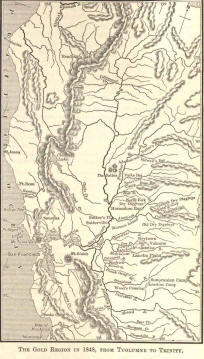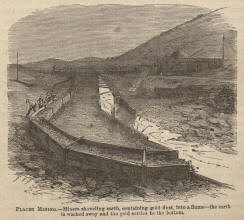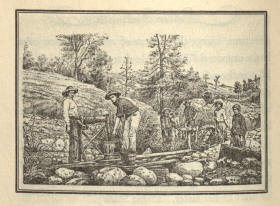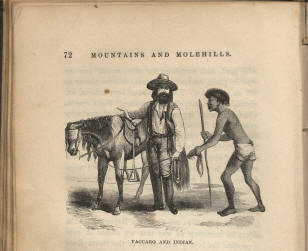|

|
Table
of Contents
Explorations
of the West
Sam
Dalsheimer
Caitlin
Goss
Nick
Schradle
David Sena
Representations
of
Native Americans
Richard
Dybas
Amanda Leong
Cynthia
Robertson
The
Western Railroads
Ronni Toledo
Kayt
Fitzmorris
Jon Ingram
David
Halperin
The
California
Gold Rush
Jordan Helle
Adam
Lawrence
Marisa
Pulcrano
Patrick Ryan
California
as Western Destination/
Mediterranean Boosterism
Maddy
Kiefer
Danielle
Mantooth
Molly
Nelson
Stefanie Ramsay
Back
to Online Exhibits
Back
to SC Landing Page
|
Introduction
The
California Gold Rush infused
images of opportunity and
individual glory to thousands of
prospectors traveling west,
creating an event that was
dictated more by fictitious ideas
of wealth than of the actual
possibility. For many, the event
helped solidify the possibilities
out west, as “the discovery of
gold, always an object of
ambition, has not infrequently
been prosecuted with eagerness and
avidity, and the wildest schemes
have been proposed to obtain these
coveted treasures” (Shuck, 1869).[more]
The hysteria created
by the Gold Rush, first
appearing in San Francisco and
then throughout the entire
state of California, reshaped
not only the region, but also
the entire country, something
Hubert Howe Bancroft describes
in the History of California
Volume XXIII. However, it was
the hysteria that produced
visions of widespread gold and
wealth, as the event itself
was short-lived and not nearly
as prosperous as it was
exaggerated to be out west.
This study will focus on defining
some of the key factors of the
Gold Rush, and use primary source
documents to detail the experience
of the event. The California
Scrapbook, written by Oscar T.
Shuck, examines the mining tools
used by prospectors during the
Gold Rush, emphasizing the
technological advances that
changed both the state of
California and the event itself.
The idea of “panning” for gold was
often viewed as the main form of
mining during the event, yet, in
reality, it was almost a complete
myth, exaggerated by the hysteria
caused by the event. Another key
factor during
the Gold Rush was the contact
zone between Native Americans
and prospectors. Frank Marryat
illustrates the relationship
between these two groups in
his book, Mountains and
Molehills. Prospectors often
treated these people as
bloodthirsty savages, a
treatment which Edward Said
would define as a clear
example of Orientalism, thus
allowing prospectors to obtain
powerful hegemony over these
indigenous people.
Furthermore, the lack of
government and political
institutions created an
emphasis on individuality in a
world of increasing crime,
which is expressed in The
Letters of Dame Shirley, by
Louise Amelia Knapp Smith
Clapp. This problem was a key
reason why settlements became
so dangerous, as the lack of
an organized society drove
prospectors to care little
about the ethics and laws of
society and thus, focus
entirely on individual ideals
of wealth.
The Gold Rush
impacted the not only the
country, but also the world,
as prospectors became so
engrossed with the idea of
wealth and glory that they
were willing to give up almost
anything in order to have a
shot at the “American Dream”.
The mythologies of the Gold
Rush provided people with an
unprecedented ambition; the
drive to obtain gold fueled
desires to obtain a lifestyle
that had the potential to be
incredible. While the Gold
Rush was often viewed as a
powerful antidote to withering
western expansion, its true
nature provided prospectors
with only dreams of wealth, as
almost everyone did not
“strike" it rich.
[i] Cabeza de
Vaca, Adventures in the Unknown
Interior of America, (New Mexico:
Crowell-Collier Publishing
Company, reprinted in 1983), p.63
[ii] Dame Shirley, California in
1851[-1852] ; the letters of Dame
Shirley, (San Francisco: The
Grabhorn Press, 1933), p. 120
[iii] Dame Shirley, California in
1851[-1852] ; the letters of Dame
Shirley, (San Francisco: The
Grabhorn Press, 1933), p. 122
|
|

History of California
Volume XXIII

- Jordan Helle
"California’s
Initial Reaction and
Hysteria to Discovery of
Gold"
The quick and sudden
explosion that was the
California Gold Rush was the
substance of myth just as
much as fact. Chapter
IV in Bancroft’s
History of California Vol.
XXIII provides
excellent insight into the
madness that the discovery
of gold brought to
California in 1848, which
would lead to the mass
migration of gold seekers
from all corners of the
globe in 1849.
Initially, the first
discovery of the precious
metal did not create much
buzz at all. But after
a couple of months passed
and a few more found gold,
the rush was on and an
entire territory was
captivated.
Bancroft describes the
initial reaction to the
discovery of gold as filled
with skepticism, and not
even given much press in
local newspapers. However,
once a few more discoveries
were made, such as the one
by the Mormon leader Samuel
Brannan, people “were thrown
into a fever of excitement”.
[1] Bancroft used
Brannan’s discovery as an
example possibly because he
was a strong religious
leader and “man of God” who
held a lot of credibility,
increasing the likelihood
that people would start
believing there were
actually riches in the
hills.
San Franciscans now started
to believe, and many went as
far as immediately dropping
everything and just
leaving. They blazed
new trails, many after
selling everything they had.
[2] It is almost
unimaginable to think of the
atmosphere created by the
discovery of gold and
ensuing spread of news by
tall tales and word of
mouth. The fever that
Bancroft mentions sweeps San
Francisco completely as the
legend grows. Gold was
discovered in January and by
June three-fourths of the
male population had left for
the mountains in search of
riches they have only heard
of, leaving the city all but
abandoned. [3]
The hysteria was not
confined to just the city of
San Francisco, as soon all
of California had heard for
themselves. People
from all walks of life
figuratively dropped
everything and went as
“judges abandoned their
benches, doctors their
patients, soldiers fled
their posts, and criminals
slipped their fetters”. [4]
It was a sight to see as all
humanity left and gave up
their homes. The
landscape was suddenly
barren of human presence and
the “country seemed as if
smitten by a plague”. [5]
For miles and miles it would
have appeared as if all
humans had been wiped off
the face of the earth.
All of California was now
packed into the hills, as
widespread mythical tales of
gold and riches drew
them. Once there,
these fortune seekers took
to mining the hills in
search of the precious
metal. Soon to follow
was the rest of the country
and the world as the news of
gold would only continue to
spread and as the tale grew
taller. With the flood
of people whose sole purpose
was to search for wealth and
riches, there came an
atmosphere with little law
and justice.
[1] Hubert
Howe Bancroft, History
of California Volume XXIII
(San Francisco: History
Company, 1888), 56.
[2]
Bancroft, History of
California, 58.
[3] Ibid,
59.
[4]
Ibid, 62-63.
[5] Ibid, 63.
Return to Top
|
|

California Scrapbook

- Adam
Lawrence
The California Gold
Rush brought prospectors
from around the country in
search of wealth and a
desire to experience the
seemingly infinite
possibilities that the
region had to offer. As a
primary source, the
California Scrapbook,
complied by Oscar T. Shuck
in 1869, contains not only a
plethora of information
about the expansion and
history of the Gold Rush,
but also about the manner in
which this gold was found
and mined. Mining
technologies during the Gold
Rush paved the way for many
instrumental techniques that
built wealth and prosperity
in California, however, the
ideas of panning and
individuality within mining
were mere myths to the event
itself.
At
the start of the Gold Rush,
individualistic attitudes
coupled with a tremendous
quantity of gold brought the
desire to mine without any
delay nor complication. This
resulted in the development
of placer mining (also known
as panning for gold), which
involved shoveling the earth
for gold dust in sandbanks
looking for alluvial
deposits which could contain
the precious resource. Even
before the events before the
Gold Rush, “traders who
visited [California]
obtained small quantities of
gold dust from the earth in
the southern part of the
state” [1]. Although many
prospectors were attracted
to the simplicity and
immediate wealth of placer
mining, gold began to
diminish quickly in
quantity, and a more
collective process of mining
began to develop in Northern
California. During the
majority of the Gold Rush,
panning was rarely
utilized, yet it was a tool
used cherished by many,
including Frederick Jackson
Turner, to endorse and
celebrate the individuality
and possibility out on the
Frontier [2]. While
prospectors and westerners
saw visions of glorious
wealth in San Francisco, the
mining industry, which
helped dictate the influx of
wealth during the event, did
not share these emotions.
Within
a year after the first
finding of gold at Sutter’s
Mill, other forms of mining
were needed to reach veins
of pay dirt. Thus, hard-rock
mining and other forms of
hydraulic mining became
prominent tools to search
for these mineral deposits.
Shuck later notes that there
became not only a desire to
mine for gold, but also to
mine for other precious
minerals that stood in the
way of prospectors and
businessmen [3]. This often
drove prospectors to
carelessly mine in even the
heaviest banks of
sedimentary volume or on
lands of Native American
people (causing major
conflicts). Thus, after the
hysteria of placer mining,
mass mining became the only
reliable technique to
increase the quantity of
gold found in California,
diminishing the ideals of
individual fame and fortune
that the Gold Rush is often
associated with in a
positive light.
The
symbols of fortune and
prosperity that stem from
placer mining during the
Gold Rush often takes a
forefront in defining the
era as a whole. While the
notion that success and
opportunity awaited anyone
who traveled to California
during this time may have
been accurate within a span
of several months in 1848,
the Gold Rush was, in
reality, little more than a
myth, causing prospectors in
search of fame and glory to
fall back onto the mercies
of corporate mining moguls
who offered minuscule profit
for intense labor.
Return
to Top
|
|

California in 1851[-1852]
; the
letters of Dame Shirley

- Marisa
Pulcrano
"Justice
in the Gold Rush"
Frederick Jackson Turner’s
frontier was a place where
“savagery met civilization”,
where government
institutions were a foreign
concept and hierarchy was
inexistent, with populations
having “no chiefs [1],” as
explorers as far back as
Cabeza de Vaca discovered
with surprise. Similarly,
the societies created by the
California Gold Rush had
only a fragment of
government structure and
authority. Beginning on the
Overland trail, the
inherited power structure
was left behind, to be
replaced by the immigrants’
new and constantly evolving
relationships. However, the
Native Americans’
anti-proprietorship society
and the mining communities
diverged because of one
critical element: gold. This
material, which combined
natural and social
advantages and which
directly conferred great
fame and fortune, caused
primal desires to surface
and gave prospectors
something worth stealing and
fighting over. Louise Amelia
Knapp Smith Clapp describes
life at the gold mining
camps of mid-19th-century
California in The
Shirley Letters. Under
the pseudonym “Dame
Shirley,” she gained a
first-hand experience of the
opulence generated by the
Gold Rush at its beginning,
with the creation of a
flashy and rich mining town,
where gambling and drinking
the gold-dust away was a
constant occupation. When
one of the miners, Little
John, is convicted of gold
theft, Dame Shirley can’t
believe that “the last
person that would have been
suspected,”[2] was capable of
theft, which illustrates
just how strong a motive
gold was for even the most
innocent.
Enforcing
new, hierarchical rules on
the frontier was clearly
difficult. In the Gold Rush,
having left all familiar
structures behind,
individuals were free to
embody a new personality in
their quest for wealth and
other life opportunities.
The newly constituted
communities had to find ways
to deal with the increased
recklessness on the trail,
which meant instituting a
popular judicial system. In
Dame Shirley’s mining
community one encounters a
Squire, however he had a
lesser impact on judicial
decisions than did the
miners. In Little John’s
trial, a president and a
jury were elected from
amongst the miners, while
the Squire was allowed to
“play at judge sitting at
the side of their elected
magistrate,”[3]a task which
he docilely accepted. The
mob was ultimately
responsible for deciding to
hang Little John, which was
the sentence for most men
having stolen even small
amounts of gold. Turner
emphasized the positive
necessity for the
dismantling of power
structures on the frontier;
however Dame Shirley
illustrates the downsides of
lawlessness in a society
struggling to rebuild their
hierarchy. This schism was
due to gold, as it caused a
frontiersman to privilege
their individual desires for
wealth over the growth of
their society. The mythology
of the Gold Rush was a
powerful motive that could
turn any man or woman into a
thief, but one that also
generated a hierarchical
structure within the
frontier’s community.
[1]
Cabeza de Vaca, Adventures
in the Unknown Interior
of America, (New
Mexico: Crowell-Collier
Publishing Company,
reprinted in 1983), p.63
[2]
Dame Shirley,
California in
1851[-1852] ; the
letters of Dame
Shirley,
(San Francisco: The
Grabhorn Press, 1933), p.
120
[3]
Dame Shirley,
California in
1851[-1852] ; the
letters of Dame
Shirley,
(San Francisco: The
Grabhorn Press, 1933), p.
122
Return
to Top
|
|

Mountains and Molehills

- Patrick
Ryan
The Gold Rush in
California created a
frontier contact zone
between prospectors and the
native peoples of
California. Many people who
traveled west on the
overland trail seeking gold
were greatly concerned with
how to deal with the native
“savages”. The book Mountains
and Molehills is an
excellent primary source
document that explores the
interactions between the
Native American tribes of
California and the gold
prospectors.
The discovery of Gold in
California in 1848 drew
large numbers of people who
wanted to find wealth and
pursue the American dream.
The Native Peoples of
California were clearly
viewed by many prospectors
as a source of danger that
needed to be dealt with:
Indians--laboring
under the ridiculous notion
that anything can belong to
them that the white man
wants—become troublesome, it
is customary to drive them
back; but the Indians of
this regime when so driven,
will find their revenge in
carrying on an exterminating
warfare against the overland
emigration—at least so it
appears to me.[1]
The indigenous people of
California are viewed as a
bloodthirsty band of savages
who were driven solely by
greed for gold and for
anything else the
prospectors were after. The
author of this text clearly
believes that the Indians
have no right to own
property like white men do.
The most prevalent method of
dealing with native peoples
appears to be to drive them
away from any areas that
might contain gold or other
precious resources that the
whites desired. In reality,
the native peoples did not
pose a serious threat to
mining interests and were as
much a part of the mythology
of the Gold Rush as the
mythology of the frontier.
Furthermore, the author
accuses the natives of
“carrying on an
exterminating warfare”. The
hypocrisy of this assertion
cannot be overlooked in
light of the numerous
atrocities and genocides
that the United States
government perpetrated on
the indigenous peoples of
North America.
This account describing
perceptions of Native
Americans clearly comprises
what Edward Said termed an
“Orientalist Discourse” that
denigrates the natives of
California as nothing more
than animals driven only by
the desire for gold and
bloodshed. [2] Moreover, the
text implies that there is
no “Middle Ground”, as
defined by Richard White,
between the natives and the
prospectors because the
prospectors exert a clear
hegemony over the natives.
[3] The Indians are not
bargained or negotiated with
but are usually driven away
from mining areas by force
and many are moved onto
reservations by the U.S.
Government. This book’s
description of the frontier
seems to fit into Frederick
Jackson Turner’s framework
very well as the far west is
a place filled with violent
“savages” and a general
atmosphere of rampant
lawlessness. [4] The result
is a text that attempts to
justify the Gold Rush craze
as well as the blatant
disregard toward Native
American ownership of the
land.
Return to Top
|
|
About
this Project / Acknowledgements
Occidental
College's "American Frontier"
Research Seminar was developed by
Dr. Jeremiah B.C. Axelrod, Adjunct
Assistant Professor of History.
The library project
is developed in collaboration with
the Special Collections
Department:
Dale Ann Stieber, Special
Collections Librarian
with student staff
Henry Boule and Claire Lem and
Laila Tootoonchi and Anahid
Yahjian.
Title Image:
Thomas Moran, "Nearing Camp,
Evening on the Upper Colorado
River, Wyoming, 1882," from
http://www.boltonmuseums.org.uk/collections/art/paintings_prints_and_drawings/oil/nearing_camp_moran
|
|
Page last edited on 03/12/2013.
Occidental
College Library Special
Collections & College Archives
© 2009 Occidental College
|
|
|
|
|